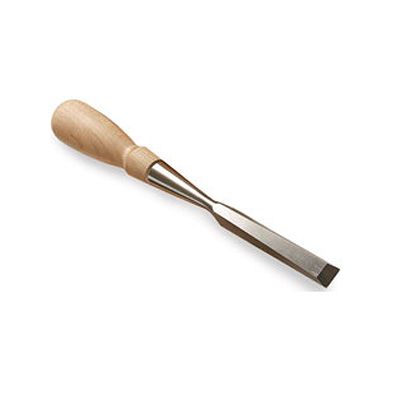Lie-Nielsen - Bench Chisel
Patterned after vintage Stanley No. 750 socket chisels. these chisels are availabe in five sizes
This chisel was almost flawless out of the box. Its back was lapped flat and nearly polished, and its beveled edges were milled and tapered precisely. However, it is the tool’s size and feel that make this the ideal bench chisel. It is lightweight and balanced, yet stout enough for rugged work, in part due to its socket design. Its mid-range length is great for controlled detail work, yet its blade is long enough for moderate-range paring. The A2 blade’s durability found a spot in the middle of the pack, but in spite of this, the ergonomics prevailed.
Past review:
Lie-Nielsen Debuts First Set of Chisels
by William Tandy Young
4/1/2005

Having made its name producing high-quality handplanes and saws, Lie-Nielsen Toolworks now completes the classic hand-tool trilogy with the introduction of its first chisels.
Patterned after vintage Stanley No. 750 socket chisels (which I have been collecting and using for years), the Lie-Nielsen chisels are more refined and versatile, yet they’re every bit as rugged and serviceable. They also have the broken-in feel of well-maintained older tools.
The hornbeam handles are clean and simple, with no bothersome rings or end caps. They also are very durable and easily withstand the blows of a brass mallet or Japanese chisel hammer, which makes for crisp, efficient chopping cuts.
With an average blade length of 3-1/4 in., the Lie-Nielsen chisels are shorter and easier to control than many longer, European-style bench chisels and are well suited to all sorts of tasks at the bench. The hardy A-2 tool-steel blades are carefully machined, which makes grinding and honing easy. Because the backs are so accurately dressed, I was able to get these chisels honed, flattened, and put to work quicker than any other chisels I’ve ever used. This by itself makes them a good value, as anyone who has slaved over rusty or poorly machined chisels knows all too well.
The Lie-Nielsen chisels will take an edge that’s almost as keen as that of a good Japanese chisel, but they will hold that edge longer. Plus, the new chisels are cheaper and in the long run less fussy to maintain, which is why they have become the everyday chisels of choice in my shop. Without hesitation, I use them for crude tasks like scraping glue, as well as for making delicate, refined paring cuts. At roughly $50 bucks apiece, these chisels are a worthwhile investment.
—William Tandy Young builds and refurbishes furniture in Stow, Mass.
More on FineWoodworking.com:
- Get a big chisel for little work
- Making Sense of Sandpaper – Knowing how it works is the first step in choosing the right abrasive
- Flawless Curves on the Bandsaw – Tricks and tips for surprisingly smooth cuts
Fine Woodworking Recommended Products

Suizan Japanese Pull Saw

Tite-Mark Marking Gauge

Lie-Nielsen No. 102 Low Angle Block Plane





















Log in or create an account to post a comment.
Sign up Log in